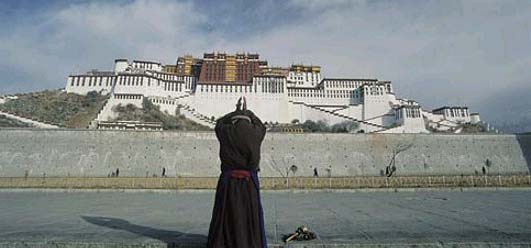


A brief introduction on Tibet
Invaded by China in 1949-50, the independent country of Tibet was forced to face the direct loss of life that comes from battles and, soon after, the loss of universal freedoms that stemmed from Communist ideology and its programs such as the Cultural Revolution (1967 - 1976). However, it is erroneous to believe that the worst has passed. The fate of Tibet's unique national, cultural and religious identity is today seriously threatened and manipulated by the Chinese.
China's policy of occupation and oppression has resulted in no more or less than the destruction of Tibet's national independence, culture and religion, environment, and the universal human rights of its people. China has broken international laws and routinely violates its own constitution by inflicting this destruction, yet time and again goes without punishment.
National Independence
With a written history of more than 2000 years, Tibet existed as an independent sovereign state prior to Chinese rule. As recently as 1914, a peace convention was signed by Britain, China and Tibet that again formally recognised Tibet as a fully independent country. But having no representation in the United Nations, the world largely stood by and allowed China's occupation and destruction to happen.
Tibetans have demonstrated repeatedly for independence from China. Ours has been a non-violent struggle, yet even when Tibetan children as young as ten whisper the words "Tibet is independent" or "Long Live His Holiness the Dalai Lama", the Chinese accuse them of trying to "split" the "motherland" and often sentence them to prison. Possessing an image of the Tibetan national flag can lead to a seven- year jail term. As of 1998, 1083 known Tibetans remain incarcerated in Chinese prisons on account of their political, religious or ethical views. Of these, 246 were women and 12 were juvenile.
Description of Tibetan National Flag
1. Historical background
One such evidence of Tibet being independent country is her nationl flag. During the reign of the seventh-century king, Songtsen Gampo, Tibet was one of the mightiest empires in Central Asia. Tibet, then, had an army of 2,860,000 men. Each regiment of the army had its own banner. The banner of Ya-ru To regiment had a pair of snow lions facing each other, that of Ya-ru Ma a snow lion standing upright, springing upwards towards the sky, and that of U-ru To a white flame against a red background. This tradition continued until the Thirteenth Dalai Lama designed a new banner and issued a proclamation for its adoption by all the military establishments. This banner became the present Tibetan national flag.
2. Explanation of the Symbolism of the Tibetan National Flag
In the centre stands a magnificient snow-clad mountain, which represents the great nation of Tibet, widely known as the Land Surrounded by Snow Mountains.
The Six red bands spread across the dark blue sky represent the original ancestors of the Tibetan people: the six tribes called Se, Mu, Dong, Tong, Dru, and Ra which in turn gave rise to the (twelve) descendants. The combination of six red bands (for the tribes) and six dark blue bands (for the sky) represents the unceasing enactment of the virtuous deeds of protection of the spiritual teachings and secular life by the black and red guardian protector deities with which Tibet has been connected since times immemorial.
At the top of the snowy mountain, the sun with its rays shinning brilliantly in all directions represents the equal enjoyment of freedom, spiritual and material happiness and prosperity by all beings in the land of Tibet.
On the slopes of the mountain a pair of snow lions stand proudly, blazing with the manes of fearlessness, which represent the country's victorious accomplishment of a unified spiritual and secular life.
The beautiful and radiant three-coloured jewel held aloft represents the ever-present reverence respectfully held by the Tibetan people towards the three supreme gems, the objects of refuge: Buddha, Dharma and Sangha.
The two coloured swirling jewel held between the two lions represents the people's guarding and cherishing of the self discipline of correct ethical behavior, principally represented by the practices of the ten exalted virtues and the 16 humane modes of conduct.
Lastly, the adornment with a yellow border symbolises that the teachings of the Buddha, which are like pure, refined gold and unbounded in space and time, are flourishing and spreading.










